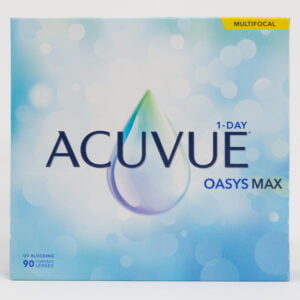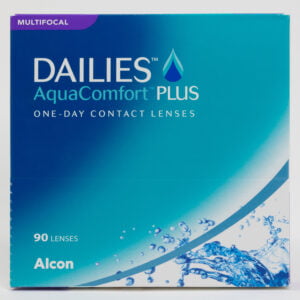Presbyopia: Definition, Causes, & Symptoms
What is Presbyopia?
Presbyopia is the gradual inability for the eye to focus that occurs as we age, due to loss of flexibility of the crystalline lens within the eye.
The lens is made of elastic proteins that give flexibility to the lens, but as we get older, the elastic proteins begin to lose their flexibility. Therefore, focus simply becomes more strenuous.
We don’t immediately lose all of our focus, but as the lens hardens, our ability to flex the lens becomes less. This isn’t because our muscles get weak, it’s because it’s more difficult for the muscles to flex a hardened lens.

Presbyopia Explained (Video)
Symptoms and Signs of Having Presbyopia
On average, when people reach their forties, they begin to notice that they begin to lose their ability to refocus on things when transitioning from far- and near-distance vision.
In the early stages, it may feel like the eye has to work harder than before.
- The eyes seem to “burn out” earlier in the day as time passes
- Extra eye strain
- Headaches
- Blurred vision
The effects of presbyopia may be similar to what’s experienced in those with myopia or hyperopia, however, the cause between these conditions differ.
How Common is Presbyopia?
Because presbyopia is a natural progression as our eyes age, everyone will at some point experience presbyopia if their eyes reach the age where the lenses start to become less flexible.
What Causes Presbyopia?
Is Presbyopia Hereditary?
No, presbyopia is not hereditary necessarily. Presbyopia is completely part of human nature, so you can’t blame your parents for this one. Everybody experiences it as our eyes age and our lens begins to harden and lose its flexibility.
Can Presbyopia be Prevented?
At this point, no, there is no way to prevent presbyopia from occurring. There is science out there for eye drops that are meant to bring the elastic proteins back to a flexible state, but the existence, safety, and efficacy of such a drop’s capabilities remains to be seen.
How is Presbyopia Treated?
After a person with presbyopia has their distance vision corrected, they will also need additional help for near vision. This is where different power values in prescriptions come into play.
On a contacts or glasses prescription this is called additional power, or “ADD power.” Light is corrected on the fovea for far, then shifts behind the fovea when we look at things up close. To move the point back onto the fovea to see well both near and far, we need to move the focus point forward (+) for a given distance.
The focus help we need to give someone depends upon how close they are viewing, and how inflexible their lens has become.
Generally, glasses can come with these potential ADD powers:
- +0.75
- +1.00
- +1.25
- +1.50
- +1.75
- +2.00
- +2.25
- +2.50
For contact lenses these are simplified into three options:
- Low (for +0.75, +1.00, +1.25)
- Medium (for +1.50, +1.75)
- High (for +2.00, +2.25, +2.50)
Popular Lenses for Presbyopia
-
Product on sale
 Clariti 1 Day Multifocal (90 pack)Original price was: $98.50.$84.99Current price is: $84.99.
Clariti 1 Day Multifocal (90 pack)Original price was: $98.50.$84.99Current price is: $84.99. -
Product on sale
 ACUVUE® OASYS MAX 1-Day Multifocal (90 pack)Original price was: $174.50.$124.99Current price is: $124.99.
ACUVUE® OASYS MAX 1-Day Multifocal (90 pack)Original price was: $174.50.$124.99Current price is: $124.99. -
Product on sale
 Dailies AquaComfort Plus Multifocal (90 pack)Original price was: $133.75.$99.99Current price is: $99.99.
Dailies AquaComfort Plus Multifocal (90 pack)Original price was: $133.75.$99.99Current price is: $99.99.
Which Brand of Contact Lens Should be Used for Presbyopia?
All major contacts brands make contact lenses for presbyopia.
You will find that the multifocal designs between the companies, even though all of the optics are confined to the small area of the pupil, have varied approaches.
For example, with Acuvue’s new multifocals, they provide unique technology of “Pupil Intelligent Design” which varies the optic zone based upon your prescription, where the other companies do not. That doesn’t mean that other companies’ designs are inferior, but they have a different approach that does not incorporate this technology.
It usually takes a few trial lenses to figure out what brand works best for you, but your doctor will have a good idea before you even start, so it’s important to schedule an eye exam.
We recommend daily disposable for safety and simplicity if your budget allows, but what will ultimately determine your choice of brand will likely be your lifestyle and your discussion with your eye doctor.
Once you have your prescription, shop online with us for the top brands at the lowest prices with free delivery.
Should I Get Glasses or Contacts for Presbyopia?
If you have presbyopia, then you should either wear glasses or glasses in combination with contact lenses.
Contact lenses should not be worn exclusively, as they have inherent risks that can be avoided by letting the eye breathe. If you don’t have glasses, then you may not give your eye enough oxygen. So, if you must get one or the other, get glasses first.
Sometimes, contacts can be a better choice to keep the image sizes the same so binocular vision (two eyes being used, but perceiving only one image) is easier.
What are the Differences Between Glasses and Contact Lenses for Presbyopia?
There are various options for both glasses and contacts for correcting presbyopia.
Glasses for Presbyopia
- Standard Glasses: For regular glasses, you would need three separate pairs:
- For viewing items far away
- For mid-distance vision such as a computer (within 24 inches)
- For close-distance vision such as reading (within 16 inches)
- Lined Bifocals: With bifocal lenses you get two of those distances- far, medium, or near.
- Lined Trifocals: With this option, you get all three distances.
- ”No-line” Progressive Multifocals: This gives all three focal ranges in a slow ramped progression of power from the top to bottom of the lens.
In each design, both eyes contribute to binocular vision without any compromise to vision quality, just as long as you can find the correct zone to see through.
Since your glasses don’t move with your focus, your eyes must shift into the appropriate angle to see clearly for the given distance, which can take some time to adjust and get used to.
Contacts for Presbyopia
With contact lenses, there are two focal options: monovision and multifocal.
Monovision would require using two different prescriptions for different vision issues in each eye. One contact lens would be for far-distance viewing and the other contact lens for seeing at the distance of your choice, either medium or close.
Monovision usually has your dominant eye (preferred viewing eye, kind of like being right or left handed) for far away and your nondominant eye for near. Notice that this design does NOT allow for binocular vision.
The other option in contacts that allows for binocular vision is Multifocal contact lenses. Multifocals in contacts are nothing like multifocals in glasses.
Since contacts do move with your eye, unlike glasses, far and near optics have to align over the pupil, because that is where light enters the eye. Therefore, both far and near focal zones of the contact are permanently situated within your line of sight.
Besides always having binocular capability, the good news is that you don’t have to find the correct zone, because it’s always there. The bad news is that since both optic zones are in your line of sight, neither eye has vision dedicated completely to either distance or near. Vision is therefore mildly compromised in comparison.
Contact companies have been working on contact lenses relentlessly on engineering designs to improve the quality of vision with multifocal contact lenses. In recent years, companies have definitely improved the nature of multifocal lenses in comparison to how they first began.
Need Consistanly Cheap Contacts?
DeliverContacts.com always guarantees you are paying low prices, every time you buy. We will never play games with our pricing or take part in manipulative discounts. Just consistently cheap contacts, forever.
Give your box a search below and see for yourself! 100% Free shipping and returns on all products!
Check out our most popular lenses
Get The Lowest Prices, Forever!
We will never send you junk or give out your information. The only emails you'll get from us are ones you be glad you got.



